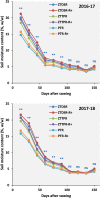Crop rotation and tillage management options for sustainable intensification of rice-fallow agro-ecosystem in eastern India
- PMID: 32636432
- PMCID: PMC7341809
- DOI: 10.1038/s41598-020-67973-9
Crop rotation and tillage management options for sustainable intensification of rice-fallow agro-ecosystem in eastern India
Abstract
Presently, rice-fallows are targeted for cropping intensification in South Asia. Rice-fallows a rainfed mono-cropping system remain fallow after rice due to lack of irrigation facilities and poor socio-economic condition of the farmers. Nevertheless, there is the scope of including ecologically adaptable winter crops in water-limited rice-fallow conditions with effective moisture conservation practices. The study aimed to identify the winter-crops that are adaptable and productive in rice-fallow conditions and to evaluate the different tillage-based crop establishment practices for soil moisture conservation, grain yield, economics, and sustainability parameters. Six different crop establishment and residue management (CERM) practices viz., zero-tillage direct seeded rice (ZTDSR), zero-tillage transplanted rice (ZTTPR), puddled transplanted rice (PTR), ZTDSR with rice residue retention (ZTDSRR+), ZTTPR with rice residue retention (ZTTPRR+), PTR with rice residue retention (PTRR+) as main-plot treatment and five winter crops (chickpea, lentil, safflower, linseed, and mustard) as sub-plot treatment were evaluated in a split-plot design. The productivity of grain legumes (chickpea and lentil) was higher over oilseed crops in rice-fallow conditions with an order of chickpea > lentil > safflower > mustard > linseed. Among the CERM practices, ZTDSRR+ and ZTDSR treatments increased the grain yield of all the winter crops over PTR treatment, which was primarily attributed to higher soil moisture retention for an extended period. Grain yield increment with conservation tillage practices was highly prominent in safflower (190%) followed by lentil (93%) and chickpea (70%). Rice grain yield was higher (7-35%) under PTR treatment followed by ZTDSR treatment. Conservation tillage practices (ZTDSR, ZTTPR) reduced energy use (11-20%) and increased the energy ratio over conventional tillage practice (PTR), higher in rice-safflower, rice-lentil and rice-chickpea rotations. Higher net return was attained in rice-safflower and rice-chickpea rotations with ZTDSRR+ treatment. Predicted emission of greenhouse gases was markedly reduced in ZTDSR treatment (30%) compared to ZTTPR and PTR treatments. Hence, the study suggests that cropping intensification of rice-fallows with the inclusion of winter crops like chickpea, lentil, and safflower following conservation tillage practices (ZTDSRR+ in particular) could be the strategic options for achieving the higher system productivity, economic returns, and energy use efficiency with the reduced emission of greenhouse gases.
Conflict of interest statement
The authors declare no competing interests.
Figures






References
-
- Kumar R, Mishra JS, Upadhyay PK, Hans H. Rice fallows in the Eastern India: problems and prospects. Indian J. Agric. Sci. 2019;89:567–577.
-
- Gumma MK, et al. Mapping of rice–fallow crop land areas for short-season grain legumes intensification in South Asia using MODIS 250 m time-series data. Int. J. Dig. Earth. 2016;9:981–1003. doi: 10.1080/17538947.2016.1168489. - DOI
-
- Layek J, Chowdhury S, Ramkrushna GI, Das A. Evaluation of different lentil cultivars in low land rice-fallow under no-till system for enhancing cropping intensity and productivity. Indian J. Hill Farm. 2014;27:4–9.
-
- Yadav GS, Datta M, Saha P, Debbarma C. Evaluation of lentil varieties/lines for utilization of rice fallow in Tripura. Indian J. Hill Farm. 2015;28:90–95.
-
- Singh RG, et al. Opportunities for managing rice fallow systems with conservation agriculture technologies. Indian Farm. 2012;62:31–34.
Publication types
LinkOut - more resources
Full Text Sources

